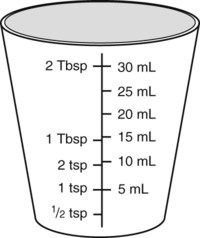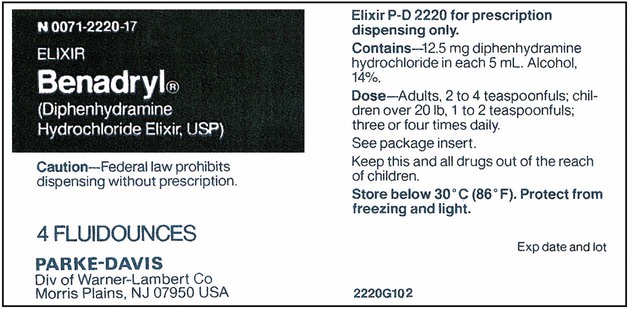Calculation of Medications for Special Populations Based on Body Weight and Patient Age
• Calculate doses of medications for children and adults using body weight
• Calculate doses of medications for children using Clark’s rule
• Calculate doses of medication for special populations based on body surface area
• Calculate doses of medication for infants using Fried’s rule
• Calculate doses of medication for children using Young’s rule
Calculating Medication Doses By Body Weight
< ?xml:namespace prefix = "mml" />






Again, ounces may be canceled and the means and extremes multiplied or



Now convert total weight to kilograms for the child weighing 18.25 lb.




The steps for calculating mg/kg are as follows:
1. Obtain the weight of the patient, and calculate that weight into kilograms.
2. Read the physician’s order for the strength or weight of the medication that is to be provided to the patient.
3. Complete the calculation of medication of “mg/kg” by multiplying.
4. After obtaining the dose of medication to be administered, use the ratio and proportion, dimensional analysis, or formula method to calculate the dose in either solid tablets or capsules or volume of liquid medication as shown in Chapters 7 and 8. If the medication needs reconstitution, use the knowledge from Chapter 9 to reconstitute the medication.
If you need to review the mathematical calculations for doses of liquid medications, refer to Chapter 8. If the medication is in a solid form, review Chapter 7 as needed.
Use Of Clark’s Rule For Pediatric Dosage

OR if weight in kilograms is to be used, the calculation formula would be

Using Clark’s rule, the following equation would be appropriate:






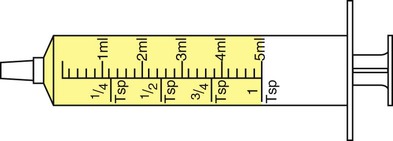

Calculating Dosage Using Body Surface Area
The third method of drug calculations using body weight is BSA. BSA is based on weight compared to height of the person. This form of calculation is often used for pediatric patients, but it may also be used when preparing toxic medications such as chemotherapeutics for adults or for adult medication amounts for the elderly, who are not of height or weight to be classified as “average adult.” This calculation provides the most accurate determination of the therapeutic dose to be administered on the basis of body weight/height. BSA refers to the total body area that is exposed to the environment and is expressed in square meters (m2). To calculate BSA, or m2 (meters squared), the weight and height of the person must be measured and then used for the calculations. These measurements may be accomplished either in the metric or English systems for use with the nomogram, a means of using a chart to plot height and weight and to provide the estimated square meters of BSA. The children’s nomogram is seen in Figure 10-1. A nomogram specific for adults is also available for use with adults who fall outside what is considered normal weight for height or those who are being administered toxic medications (Figure 10-2). The nomogram to be used is based on the person’s age or on the nomogram’s limitation by height and weight.
Figure 10-3 shows the use of the nomogram; notice that the person is 41″ tall and weighs 36 lb. The intersection of the straight line on the SA line is 0.68, so the estimated BSA for this patient is 0.68 m2.
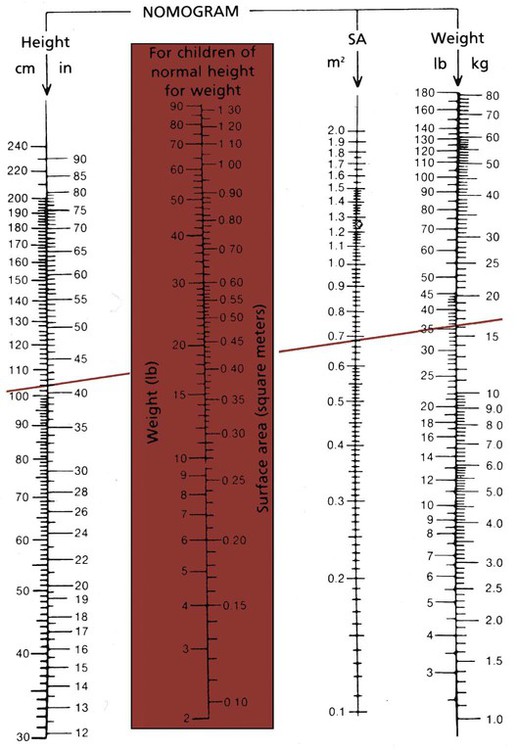


If the medication is in a vial of 200 mg/10 mL, what would be the volume of medication?


Calculation Of Medications For Pediatric Patients Based On Age
Fried’s Rule
Fried’s rule is to be used with infants up to 1 year.

If the medication available is amoxicillin 50 mg/mL, what dose would be given to the infant?



The infant would receive amoxicillin 0.4 mL if the dose is based on age.
Review of Rules
Calculation of Medication Doses Based on Age or Weight
• Medications for special populations may require special calculations based on either weight, age, or BSA.
• Medications may be ordered in the drug strength to be given for the weight in kilograms (strength/kg/time period [such as day or hours]). To calculate these problems, weight in pounds must be converted to kilograms before performing the calculation. To calculate kilograms, divide the number of pounds by 2.2 (2.2 lb = 1 kg). This calculation may be easily accomplished using the ratio and proportion method. (If dimensional analysis is the preferred method of calculation, this conversion is not necessary because it may be done as a step in the problem.) After the kilograms have been calculated, complete the formula of mg/kg by substituting the order and the calculation of kilograms.
• Doses calculated on age are not generally used because age alone as the criterion for calculations is not considered to be singularly valid for this determination.
• Clark’s rule may be used to calculate a pediatric dose of medication by inserting the known information into the following formula:

• BSA is based on the nomogram to find the meters squared (m2) of the body’s external area. The nomogram is available for either children or adults, and the correct nomogram must be used when calculating medications.
• To use the nomogram, find the height in either inches or centimeters in the height column. Then find the weight in either pounds or kilograms in the weight column. Finally, draw a line connecting the height point and the weight point of the child. The number on the m2 line where the line intersects the surface area (SA) column is the BSA.
• After finding the BSA, use the following formula and fill in the known amounts to calculate the dose for special populations.

• Age may also be used to calculate medication dosages for children.
• For infants (ages birth to 12 months), Fried’s rule may be used:

• For children between 1 and 12 years old, Young’s rule may be used:

After the dose for the child has been calculated, the formula or ratio/proportion must be used to complete the calculation for the desired dose.


 .
.





















 years? ____________________
years? ____________________

























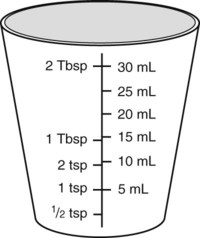



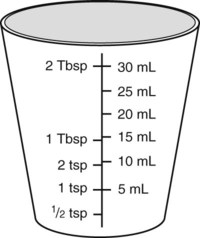







 per kg q8h prn high fever and aching. The medication available is acetaminophen 325 mg/5 mL.
per kg q8h prn high fever and aching. The medication available is acetaminophen 325 mg/5 mL.

